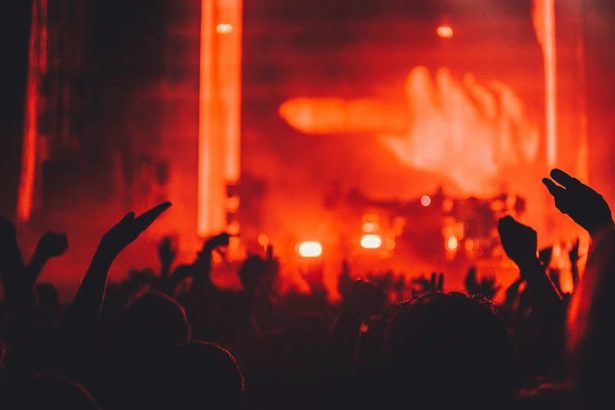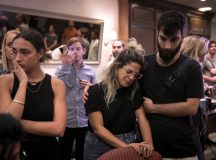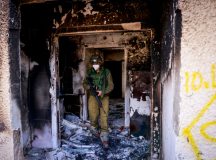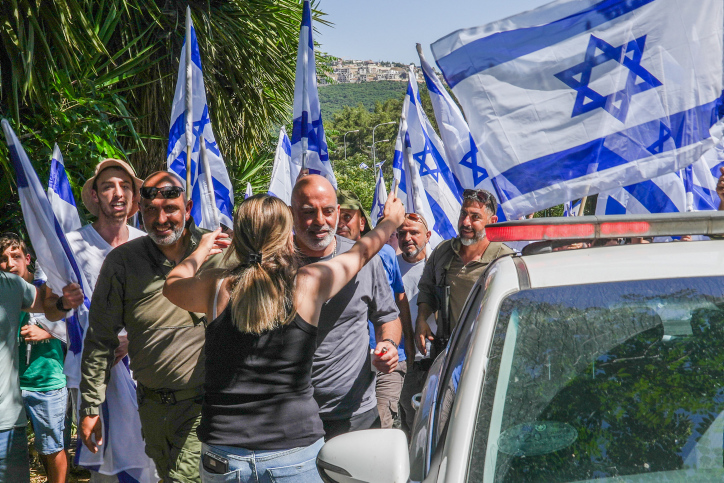Tanja Ehmann asks why, despite the massacre at the Supernova music festival, parts of the European club culture scene have been silent, or worse, about the horrors committed by Hamas. Ehmann is a lecturer in research methods and civic education at the Catholic University of Applied Sciences Berlin.
[Hamas] don’t call them ‘Israelis’ or ‘colonial-settlers.’ They simply call them ‘Jews.’ Anshel Pfeffer, Haaretz, 30 November 2023[1].
During the deadliest terror attack on Jews since the Holocaust and the first antisemitic pogrom in the state of Israel, committed by the radical Islamist organisation Hamas, terrorists raped and kidnapped[2] at least 40 ravers and murdered approximately 364 people[3] who attended the Supernova Sukkot Gathering music festival in the Re’im Forest in Southern Israel, three miles from the Gaza frontier. As 3500 local and international festival goers partied on Saturday 7 October 2023 at around 6:30 AM, Hamas militants stormed the festival site on motorbikes and jeeps[4].
The Psytrance-Festival Supernova is a collaboration between Universo Parallelo a popular music festival founded almost 20 years ago in Brazil[5] and the local promoter Tribe of Nova. The genre in Israel developed from Goa-Techno, rooted in Full Moon parties on the beaches of Goa[6] to Electronic Psytrance. Psytrance is perceived as a rave culture that creates an autonomous zone of communal encounter[7] via hypnotic melodies and rhythms to celebrate spirituality and music as a way to go into a trance[8]. One of the founding myths about Psytrance is the idea that ‘it was synonymous with the diversity of the participants: a colorful bunch of very different personalities with the full range of social and societal backgrounds[9]. Psytrance events attract people from many countries and scene formations. The website Goabase announces for 2024 already 286 Goa/Psytrance parties in 40 countries[10]. Psytrance constitutes a mixture of genre influences, ‘a diversity of regional populations and scenes in which recognisable sounds have emerged or distinct fusions formed’[11]. When Rave culture and electronic dance music transformed in a pop cultural phenomenon in the mid 1990s, one of its slogans was the phrase PLUR which stands for ‘peace, love, unity and respect’[12]. The slogan does not reflect reality, it romanticises the electronic music industry, but nevertheless the slogan is a call to build spaces that promote coexistence based on inclusive solidarity and not on division and hatred.
The security authorities in Israel assume that Hamas did not have advance knowledge about the Supernova Festival and decided spontaneously to attack the event[13] but were lucky enough to catch a huge panicked crowd, which could have been even larger if it hadn’t been decided to stop the party half an hour before gunfire was first heard and to disperse minutes after the rocket attack[14]. Two days after Black Saturday the Instagram-Account ‘Survived to tell’[15] went online. It publishes videos, photos, screenshots from chat histories and reports from survivors. The accounts bear witness to the systematic humiliation, torture, murder and rape[16]. There is also a documentary from Noam Pinchas and Yossi Bloch, exposing the Hamas Supernova Festival atrocities[17].
The massacres in Israel with their horrible and cruel consequences demonstrate eliminatory hate against Jews, in a country where Jewish life was supposed safe before the 7/10. The hate of Jews and the wish for a besieged Israel to be wiped off the map can be found in both versions of the Hamas Charter[18]. The pogrom shows the murderous praxis of an anti-emancipatory ideology. The murder of people who meet in order to dance is an attack on shared values of liberal democracies: freedom of expression and identity[19], equality and coexistence, self-reflection and freedom[20]. The artist Andres Gurwicz described in an interview with Haaretz that he ‘could not stop thinking about what it’s like to be at this kind of event, with your awareness altered by various substances, influenced by the surrounding and the music, and to experience these horrors’[21]. I am stunned and appalled by the horrors, by the silence after the attack and by the reactions of people identified with club culture that followed when Israel started to fight back. As a woman who is an activist in the struggle for gender equality in the electronic music scene, I am shocked about the lack of solidarity towards the raped and massacred Israeli women*. In implementing rape as a tool for terror, Hamas committed war crimes. Rape is considered a crime against humanity in the Rome Statute of the International Criminal Court. It also violates the Geneva Conventions[22].
Resident Advisor
Resident Advisor (RA), one of leading international websites for electronic music, based in London and with branches all over the world, published one news article on the Monday after the attack on the Supernova Festival with no sign of solidarity. One month later RA informed the electronic music world with a ‘rolling resource story’ about how ‘the electronic music community is responding to the crisis in Palestine’[23]. The selected events update the readers about fundraising campaigns for humanitarian aid to inhabitants of Gaza. RA is framing the pogrom and the Israel-Hamas war with BDS narratives and as a genocide of the Palestinian people. One of the further reading recommendations by RA in this resource story is the book ‘The ethnic cleansing of Palestine’ by IIan Pappé[24]. This way of communicating solidarity with the suffering of civilians in Gaza and the military outcome in the Strip fosters a perpetrator-victim reversal. There is silence towards the horrors committed by Hamas, no solidarity with the victims and hostages and no word of empathy. The rolling story focuses exclusively on fund raising and solidarity campaigns for Palestinians and refers to mass ethnic cleansing in Gaza. An article that was published on the 85th anniversary of the Novemberpogroms, informs the reader about artists who support Palestine lose their work and experience defamation for expressing solidarity ‘in the face of Gaza’s current decimation’ or ‘voicing anti-genocidal sentiments’[25]. From my perspective, the platform, as a major player in the electronic music industry, is responsible for a normalisation of anti-Jewish hatred[26] in the absence of discourse about the Supernova Festival and in its one-sided coverage of perspectives following the 7/10 massacre.
DJs for Palestine
The outcry against ‘cancel culture’ shows a double standard and a Janus face because RA supported the DJs for Palestine campaign that called for the cultural boycott of artists with an Israeli background, as well as of clubs and festivals in Israel. RA, in 2018 and 2021, promoted the cultural boycott campaign under the hashtag #DJsForPalestine which was shared across Twitter, Instagram and Facebook by DJs from the UK and US, with the following statement: ‘as long as the Israeli government continues its brutal and sustained oppression of the Palestinian people, we respect their call for a boycott of Israel as a means of peaceful protest against the occupation’[27]. The campaign was coordinated by the Palestinian Campaign for the Academic and Cultural Boycott of Israel (PACBI)[28] and is part of the BDS movement. DJP has adapted the cultural boycott of the BDS supporters and sympathisers, which has already been imposed at other festivals, for example the Meteor Festival in Tel Aviv[29] and Pop-Kultur Festival in Berlin[30].
What was new about the DJP campaign was that it particularly polarised the part of the club culture scene that had previously been jointly committed against the displacement of subcultural spaces and projects, against racism and anti-migration politics, and for LGBTQI* rights. At this point, supporters of the boycott campaign imagined themselves as the true progressive opposition, on the side of the oppressed[31]. Artists and clubs that did not qualify for this progressive opposition, those who opposed the boycott and criticised the Israel-related antisemitism of BDS/DJP were defamed and cancelled[32] or attacked[33]. In discussions on Facebook and Instagram in the context of club cultural clashes in Berlin, boycott supporters created a hegemonic and exclusionary space and staged themselves as gatekeepers of human rights. They positioned themselves in an ideologized and Manichaean manner against Israel and Zionism. People who argued against the boycott were singled out and accused of being white supremacists and Islamophobic, of using their critique against antisemitism to silence voices who speak out against the apartheid and terror regime of Israel[34].
The way DJP and its followers try to force conformity, how they defend themselves against criticism of antizionist antisemitism and how they defame people and club collectives who oppose the narratives and demands continues in the current situation for example with Ravers for Palestine, “a horizontal collective of artists, DJs and individuals engaged in London’s electronic music scene, in order to highlight the solidarity between these individuals in support of Palestinians, as well as demand established music industry institutions take action to oppose the siege of Gaza”[35].
Berlin Clubcommission
The Berlin Clubcommission, Berlin’s alliance of clubs, festivals and cultural organisers released a statement on Instagram declaring that ‘Berlin’s Club community unites in profound sorrow and unwavering solidarity’[36]. There are protagonists from the club cultural scene, on and offline, who harshly criticised the statement as superficial and without context. The statement lacks the entire context of the terror attack, there is no clear stance against Hamas, no mention of antisemitism and not a word about the other dead, injured or hostages. Some commentators used the statement for polarising and polemical discussion about the Middle East conflict, justifying the attacks one way or the other, accusing Clubcommission of being ‘brainwashed’ and of spreading misinformation. The Clubcommission released a second statement to defend themselves, declaring that it is their task to stand against ‘misanthropy in club culture worldwide and to create a space for solidarity, mourning and empathy when such an extent of violence takes place in a club cultural context’[37]. They also assumed that it is not their task ‘to comment on the general international political landscape’ because they do not have the structures and resources ‘ in a way that does justice to our individual political positions and especially not to those of our members’[38].
What is missing in the follow-up is a clear stance against the social media comments that used the first statement of the Clubcommission to justify the pogrom and the massacre at the Supernova Festival. The Clubcommission continued not to distance itself from antisemitism and in this sense also from tolerating narratives that claim that ‘festival visitors deserved this, simply because they had dared to celebrate at a party in Israel’[39]. Furthermore, it is not a question about taking a position in the Middle East conflict. Under the current circumstances, there is no justification for de-solidarising with Israel[40]. The extent of the violence that unfolded on this day has no justification. Israel’s blockade of Gaza, the reality in the West Bank and the structural racism against Arab Israelis are not the cause for the mass murdering and no justification for slaughtering people. Why is not possible to distance oneself from the terror, to name Hamas and Islamic Jihad as being responsible for this war and to show solidarity and empathy with the victims of the massacres? Why is it not possible to address the suffering of the people in Gaza and not question Israel’s right to defend itself (to be ‘For the Total Defeat of Hamas, against the “Total Siege” of Gaza’?[41] )
The Return of the Authoritarian Personality?: The spreading denial of emotional ambivalence and intolerance of cognitive ambiguity
I assume that one of the reasons is a denial of emotional ambivalence and ‘intolerance of cognitive ambiguity’[42]. There is a reduction of ambiguous cognitive patterns by clinging to the familiar antizionist BDS rhetoric in simple and stereotyped fashion with reference to fighting terms like ‘Apartheid’, ‘genocide’ and ‘settler-colonialism’[43], including the binary of oppressor versus oppressed from prevailing forms of the post-colonial paradigm[44].
The storytelling Resident Advisor uses in the article about artists who lost their work for showing solidarity with Palestine fosters a one-sided view about 7 October. Artists refer to the pogrom as a ‘direct response’ to occupation and Apartheid, scream ‘free Palestine’ at a London protest[45] or demand to dissolve Israel and call it Palestine again – ‘a home for Muslims, Christians and Jews’[46]. With other quotes from artists in the article, RA calls out the hypocrisy and Israel`s atrocities; blames cultural institutions like clubs or radio platforms of racism and colonialism when those institutions take actions against artists who violate their anti-discrimination policies characterising this practice as ‘being erased from the Berlin cultural landscape in a wave of pro-Israeli support[47] .
Resident Advisor reproduces narratives of delegitimisation that are known from the antizionist rhetoric and actions from BDS/DJP and its supporters. Moreover, RA is framing the artists as victims of solidarity with Israel and the artists take the role of resistance fighters against an oppressive world that surrounds them[48]. There is an offer to identify with the artists and if the offer is taken, the possibility that the distance to the act of resistance gets smaller. In the abstract, Hamas becomes a solution to combat the feeling of powerlessness, frustration, anger and anxiety towards the situation of the Palestinian civilian population and the Hamas-Israel war. It is an offer to deal with the situation through antisemitically charged projections with a narrow and rigid black and white thinking[49]. This projective thinking devalues or ignores the suffering and terror and it ignores or legitimises murdering people because they are Jewish; or at least because they live, work or party in Israel. Research on manifestations of intolerance refers to responses that indicate rejecting or avoiding an ambiguous situation[50]. The ability to deal with ambiguous situations represents a central construct for the acceptance of diversity and can be seen as an important indicator for the functioning of a pluralistic society[51]. Within the framework of the authoritarian personality, intolerance of ambiguity is connected to the devaluation of others.
A member of a club collective in Berlin told the newspaper Tagesspiegel[52]when asked why the Berlin club culture, which is generally fast in declaring solidarity with marginalised voices, was silent after 7/10. The club spokesperson assumed that the bias in the club cultural context is caused by reluctance to say the wrong thing and fear of reactions, especially fear of being seen as pro-Israeli. The interpretation of the conflict launched by BDS and spread in the scene – Israel is accused of committing genocide and is defined as an oppressor and apartheid state that leaves the Palestinians and BDS supporters[53] no choice – is shared by many, and continues in the current situation in an adapted and openly aggressive version. It is a projective delusion[54] that denies the actual history of the conflict[55] and denies that chances to establish a Palestinian state were rejected many times; it denies that ‘the principal grievance of the Palestinian cause […] is not the absence of a desired nation-state but the existence of another one’[56]. It is time to free Gaza from Hamas.
[1] A version of this article first appeared at the Engage website. Anshel Pfeffer, ‘Why Hamas Killers invoked God’s name, not the Liberation of Palestine’, In: Haaretz, 30 November 2023, https://www.haaretz.com/israel-news/2023-11-30/ty-article/.premium/why-hamas-killers-invoked-gods-name-not-the-liberation-of-palestine/0000018c-2136-d21c-abae-77be854e0000?utm_source=mailchimp&utm_medium=Content&utm_campaign=haaretz-today&utm_content=400aae01b5.
[2] 28 are mentioned in the BBC News article ‘Hamas hostages: The faces of those taken from Israel to Gaza’, accessed 11 November 2023, https://www.bbc.com/news/world-middle-east-67053011.
[3] Times of Israel, ‘Death toll from Nova music festival massacre on Oct. 7 raised by 100 to over 360’,
accessed 18 November 2023 https://www.timesofisrael.com/death-count-from-music-festival-massacre-on-oct-7-up-to-over-360/; Groove.de ‘Supernova: Das Festival äußert sich zu Hamas-Angriff’, accessed 18 October 2023 https://groove.de/2023/10/17/supernova-das-festival-aeussert-sich-zu-hamas-angriff/; Statement, Tribe of Nova, Facebook, October, 14 2023 https://www.facebook.com/photo/?fbid=642480218068180&set=pcb.642480358068166
[4] Haaretz, ‘Israeli Security Establishment: Hamas Likely Didn’t Have Advance Knowledge of Nova Festival’, accessed 18 November 2023 https://www.haaretz.com/israel-news/2023-11-18/ty-article/.premium/israeli-security-establishment-hamas-likely-didnt-have-prior-knowledge-of-nova-festival/0000018b-e2ee-d168-a3ef-f7fe8ca20000?lts=1700569527041.
[5] Rolling Stone, ‘Universo Parallelo Festival: Festivalmanager berichtet vom Rave-Massaker in Israel’, accessed 9 October 2023 https://www.rollingstone.de/paralello-universo-festival-festivalmanager-berichtet-vom-rave-massaker-in-israel-2647899/.
[6] Graham Peter St John, ‘The local scenes and global culture of Psytrance’, New York: Routledge, 2010. https://www.researchgate.net/publication/273016907_The_Local_Scenes_and_Global_Culture_of_Psytrance.
[7] Arun Saldanha, Goa trance and trance in Goa: smooth striations, ed. Graham St. John, Rave Culture and Religion, London: Routledge, 2004: 271-284.
[8] SYQEL ‘A Brief-ish History of Psytrance, the Soundtrack of Psychedelic Culture’, accessed 20 October 2023, https://blog.syqel.com/history-of-psytrance/.
[9] Mushroom Magazine, ‘25 Jahre Psytrance’, accessed 18 October 2023. https://www.mushroom-magazine.com/psytrance/?lang=de.
[10] Goabase, ‘Parties and People’, accessed 20 January 2024, https://www.goabase.net/de/#top.
[11] Ibid., Graham Peter St John ‘The local scenes and global culture of Psytrance’: 2.
[12] Graham St. John, Rave Culture and Religion, London, Routledge, 2004:4. https://www.researchgate.net/publication/43456600_Rave_Culture_and_Religion/link/59cea88caca2721f434efd21/download?_tp=eyJjb250ZXh0Ijp7ImZpcnN0UGFnZSI6InB1YmxpY2F0aW9uIiwicGFnZSI6InB1YmxpY2F0aW9uIn19.
[13] Times of Israel ‘Death toll from Nova music festival’.
[14] Haaretz, ‘Knowledge of Nova Festival’.
[15] See https://www.instagram.com/survived.to.tell/.
[16] Jungle World, ‘Survived to tell. Die jüdische Tradition, Zeugnis von der Gewalt gegen Juden abzulegen’, accessed October, 26, 2023 https://jungle.world/artikel/2023/43/survived-tell.
[17] The Trailer of the documentary ‘Supernova: The Music Festival Massacre’ can be found on YouTube https://www.youtube.com/watch?v=RoEdTXTw0ds&t=11s; see also Haaretz, ‘New Film Exposing Hamas’ Nova Massacre Horrors Is Not Available to Be Watched’, accessed 1 January 2024, https://www.haaretz.com/israel-news/2023-11-12/ty-article-magazine/.premium/why-you-cant-watch-this-new-film-exposing-hamas-nova-massacre-horrors/0000018b-c373-da6e-a9df-f37fdaf10000
[18] Matthias Küntzel, Nazis, Islamic Antisemitism and the Middle East. The 1948 Arab War against Israel and the Aftershocks of World War II, New York, Routledge, 2024.
[19] Ibid. p.5.
[20] Ibid. p. 12.
[21] Naama Riba, ‘The moment before the Music turned to gunfire’, Haaretz, 14 November 2023, https://www.haaretz.com/israel-news/2023-11-14/ty-article-magazine/.premium/drawing-the-moment-before-the-music-turned-to-gunfire/0000018b-cd2e-d518-a39b-ff3f91c20000.
[22] The Algemeiner, ‘Hamas raped and massacred Israeli Women; Is there a way to hold them legally accountable?’, accessed 23 November 2023. https://www.algemeiner.com/2023/11/23/hamas-raped-and-massacred-israeli-women-is-there-a-way-to-hold-them-legally-accountable/.
[23] Resident Advisor, ‘Palestine: How to help, resources, messages of solidarity’, accessed 15 November 2023, https://ra.co/news/79707.
[24] Ibid. Resident Advisor, ‘Palestine, further reading list’.
[25] Resident Advisor, ‘’It’s sad in indescribable ways’: Artists supporting Palestine lose work, receive backlash online for expressing solidarity’, accessed 10 November, 2023. https://de.ra.co/news/79782.
[26] Matthew Bolton, ‘Celebrating Terror – new research indicates a radicalisation of antisemitic discourse about Israel online in the wake of the Hamas terror attacks’ in Fathom, November 2023, https://fathomjournal.org/celebrating-terror-new-research-indicates-a-radicalisation-of-antisemitic-discourse-about-israel-online-in-the-wake-of-the-hamas-terror-attacks/.
[27] The Quietus, ‘DJs for Palestine Campaign’, accessed 18 March 2022. https://thequietus.com/articles/25287-djs-for-palestine-campaign-four-tet-caribou-the-black-madonna.
[28] PACBI: acronym for Palestinian Campaign for the Academic and Cultural Boycott of Israel.
[29] DJ Mag, ‘DJs join online campaign in support of Palestine’, accessed 18 March 2018. https://djmag.com/content/djs-join-online-campaign-support-Palestine.
[30] PACBI already demonstrated its approach in 2017 with the boycott of the Pop-Kultur Festival in Berlin. The call for artists and visitors to stay away from the festival was justified by the need to stop Israel putting itself in a good light via cultural promotion. The Israeli embassy had financially supported an Israeli artist and paid for her plane ticket. See: Pop-Kultur ‘Official statement’, accessed 3 October 2022. https://www.pop-kultur.berlin/hintergruende-fakten-und-unser-offizielles-statement-zur-boykott-kampagne-gegen-pop-kultur-2022.
[31] Nicolas Potter, ‘Clubkultur’, in Judenhass Underground. Antisemitismus in emanzipatorischen Subkulturen und Bewegungen, ed. Nicolas Potter and Stefan Lauer, Leipzig, Hentrich & Hentrich, 2023, 144-57.
[32] Ibid. Nicholas Potter, Clubkultur: 153-56.
[33] Yaron Trax and Lutz Leichsenring, ‘BDS, Clubkultur und DJsForPalestine’, ed. Nicolas Potter and Stefan Lauer, 227-234.
[34] Tanja Ehmann, ‘A Nethnographic Approach to Antisemitism in the context of the Cultural Boycott Campaign #DJs for Palestine’, Journal of Contemporary Antisemitism, 6.1., Spring 2023, 1-16.
[35] Mixmag Magazine, “Nearly 300 electronic musicians and collectives sign Ravers for Palestine open letter”, accessed 2 February 2024, https://mixmag.net/read/nearly-300-electronic-musicians-and-collectives-sign-ravers-for-palestine-open-letter-news; see also https://www.instagram.com/raversforpalestine/
[36] Clubcommission, ‘Our collective hearts ache’, Instagram, 9 October 2023. https://www.instagram.com/p/CyL_DcysNAr/?img_index=1.
[37] Clubcommission, ‘As Clubcommission we see it…’, Statement in the comment section, Instagram, 21 October 2023, https://www.instagram.com/p/CyL_DcysNAr/?img_index=5
[38] Ibid. Clubcommission.
[39] Tagesspiegel, ‘Linker Judenhass: Es gibt einen großen Unwillen, den Antisemitismus in den eigenen Reihen zu erkennen’, accessed 9 October 2023 https://www.tagesspiegel.de/gesellschaft/linker-judenhass-es-gibt-einen-grossen-unwillen-den-antisemitismus-in-den-eigenen-reihen-zu-erkennen-10592407.html.
[40] Michaela Dudley (2023), ‘Die Doppelmoral der Hamas-Jubeltruppe’, Belltower Newsletter, accessed 10 October 2023, https://www.belltower.news/michaela-dudley-die-doppelmoral-der-hamas-jubeltruppe-153053/.
[41] Alan Johnson and Jack Omer-Jackaman (2023) ‘For the Total Defeat of Hamas, Against the “Total Siege” of Gaza’, in: Fathom, https://fathomjournal.org/opinion-against-the-total-siege-of-gaza-for-the-total-defeat-of-hamas/
[42] Else Frenkel-Brunswik, ‘Intolerance of ambiguity as an emotional and perceptual personality variable’, Journal of Personality, 18, 1949, 108–143.
[43] Balázs Berkovits, ‘Israel als weißer, siedlerkolonialistischer Staat in den aktivistischen Sozialwissenschaften’, in: Probleme des Antisemitismus. Postkoloniale Studien, Critical Whiteness und Intersektionalitätsforschung in der Kritik, ed. Ingo Elbe, Robin Forstenhäuser, Katrin Henkelman, Jan Rickermann, Hagen Schneider and Andreas Stahl, Berlin, Edition Tiamat, 2022, 520-551.
[44] Ingo Elbe, ‘Postkolonialismus und Antisemitismus’, in: Kritik des Antisemitismus in der Gegenwart, Erscheinungsformen-Theorien-Bekämpfung, ed. Stephan Grigat (Baden Baden: Nomos, 2023, 157-69).
[45] Ibid., Resident Advisor, ‘It’s sad in indescribable ways’.
[46] Ibid.
[47] Ibid.
[48] Another article on Resident Advisor titled “How we are protecting ourselves?” tells the story of an artist who was threatened online after taking down posters of the hostages in New York. RA points to the crowdfunding campaign “supporting Lita after zionist doxxing” for the artist, accessed 25 January 2024. https://de.ra.co/news/80003
[49] Sebastien Grenier, Anne-Marie Barrette, Robert Ladouceur, ‘Intolerance of Uncertainty and Intolerance of Ambiguity: Similarities and differences’, Personality and Individual Differences, 39, 2005, 593-600.
[50] Ibid. 594.
[51] Almuth Lietz, ‘Measuring Tolerance for Ambiguity: A German-Language Adaption and Validation of the Tolerance for Ambiguity Scale (TAS’), Measurement Instruments for the Social Sciences 5, 2023: Article e11211. https://miss.psychopen.eu/index.php/miss/article/view/11211
[52] Tagesspiegel, ‘Clubszene und Nahostkonflikt. Sehnsucht nach klarem Feindbild’, accessed 23 October 2023.
[53] In addition, it is no longer just about boycotting, but also about the call on other states to withdraw military support from Israel. See: Musicians for Palestine ‘2023 Letter’ accessed 24 November 2023, https://musiciansforpalestine.net/2023-letter/.
[54] Stephan Grigat, ‘Kritik des Antisemitismus heute. Zur kritischen Theorie antijüdischer Projektionen, der Persistenz des Antizionismus und der aktuellen Gefahr des islamischen Antisemitismus’. In: Ibid. Ed. Stephan Grigat, 11-50.
[55] See for example: Oren Kessler, Palestine 1936. The Great Revolt and the roots of the Middle East Conflict, London, Rowman & Littlefield, 2023, 225-45.
[56] Shany Mor, ‘Ecstasy and Amnesia in the Gaza Strip’, Mosaic Magazine, November 2023, https://mosaicmagazine.com/essay/israel-zionism/2023/11/ecstasy-and-amnesia-in-the-gaza-strip/




































